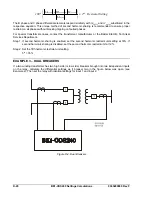
D
S
ETERMINE TAP SETTING
Calculate Ideal Taps
Step 1. Use the fo
for these equations are in
Table
D-2.
llowing three equations to calculate ideal taps. Parameters
9365200990 Rev F
BE1-CDS240 Settings Calculations
D-5
1
CTR
1
KV
COMP
*
*
3
1000
TA
*
*
1
MVA
1
P
2
*
2
*
3
2
*
1000
*
CTR
KV
COMP
MVA
2
TAP
3
*
3
*
3
3
*
1000
*
3
CTR
KV
COMP
MVA
TAP
m
P
Table D-2. Para eters for the First Two Equations
arameter
Description
Explanation
MVA
ating of the protected equipment (see
MVA Base
Full load
MVA
or top r
Note below)
KVn
KV Base for C
T input circuit
T input
n
L-L Voltage in KV for each C
CTRn
CT Ratio for CT input
n
Actual ratio, not maximum ratio
COMPn
Phase Compensation
Adjustment Factor for
CT input
n
3 if CT’s are connected in Delta (
ctcon
= DAB or DAC).
1 in all other cases.
NOTE: MVA used in Tap Calculation
Typically, the top
MVA
is used for the tap calculations, but actually any
MVA
may be used as long as
the same
MVA
is used for every calculation (TAP1, TAP2 and TAP3) even if the
MVA
is much higher
or lower than the continuous rating of the winding. The top rating of the main winding is used
typically because
te and harmonic
the tap selection has ramifications on the minimum opera
blocking features of the relay (recall operate currents and harmonic currents are in terms of
"percentage of tap"). One normally tries for a tap setting for the main windings that is in the 3-5
range, but taps well outside this range are frequently done. For the same input current, higher taps
will yield a less sensitive relay because the same current level will be a lower percentage of tap.
NOTE: Reduced MVA Winding CT Ratios and Tap Settings
When one winding has a gre
windings, the calculation for
atly reduced
MVA
rating compared to other
the tap setting on the low rated winding will result in a very high tap setting and sometimes it will be
necessary to set the CT ratio for the reduced
MVA
winding relatively high (resulting in a relatively
low secondary current during normal operation) in order to accommodate the maximum tap ratio of
the relay.
NOTE: CT Ratios and Tap Calculations
Though CT ratios might end up being affected by the outcome of the tap calculations, recall that this
is primarily a step to select taps. The CT ratios would normally be selected before the taps are
selected and the CT ratios are normally set so that normal full load current of the winding results in
secondary currents that are below the CT's continuous ratings yet high enough to produce currents
that the relay can accurately measure. For 5
t
A nominal CTs, the secondary current at full load is
ough abnormal, in the
ypically on the order of 3 to 5 A, but th
ory could be from 0.5 A to as high as
the CT's design will allow. It would be a fairly safe assumption that CTs used in large transformers
would have a thermal rating factor (TRF) of 1.33 or better, but CTs are on the market with a wide
range of TRF of 1.0 to 4.0 (per IEEE C57.13, TRF of 1.0, 1.5, 2.0, 3.0 and 4.0 are other possible
standard values) so one should verify the TRF before setting up a condition where continuous
current above of 5 A may exist.
Summary of Contents for BE1-CDS240
Page 2: ......
Page 8: ...vi BE1 CDS240 Introduction 9365200990 Rev F This page intentionally left blank ...
Page 38: ...1 28 BE1 CDS240 General Information 9365200990 Rev F This page intentionally left blank ...
Page 40: ...ii BE1 CDS240 Quick Start 9365200990 Rev F This page intentionally left blank ...
Page 152: ...ii BE1 CDS240 Metering 9365200990 Rev F This page intentionally left blank ...
Page 226: ...iv BE1 CDS240 Application 9365200990 Rev F This page intentionally left blank ...
Page 286: ...ii BE1 CDS240 Security 9365200990 Rev F This page intentionally left blank ...
Page 290: ...9 4 BE1 CDS240 Security 9365200990 Rev F This page intentionally left blank ...
Page 292: ...ii BE1 CDS240 Human Machine Interface 9365200990 Rev F This page intentionally left blank ...
Page 306: ...10 14 BE1 CDS240 Human Machine Interface 9365200990 Rev F This page intentionally left blank ...
Page 308: ...ii BE1 CDS240 ASCII Command Interface 9365200990 Rev F This page intentionally left blank ...
Page 342: ...11 34 BE1 CDS240 ASCII Command Interface 9365200990 Rev F This page intentionally left blank ...
Page 349: ...Figure 12 5 Horizontal Rack Mount Front View 9365200990 Rev F BE1 CDS240 Installation 12 5 ...
Page 361: ...Figure 12 17 Typical DC Connection Diagrams 9365200990 Rev F BE1 CDS240 Installation 12 17 ...
Page 372: ...12 28 BE1 CDS240 Installation 9365200990 Rev F This page intentionally left blank ...
Page 468: ...13 92 BE1 CDS240 Testing and Maintenance 9365200990 Rev F This page intentionally left blank ...
Page 512: ...14 42 BE1 CDS240 BESTCOMS Software 9365200990 Rev F This page intentionally left blank ...
Page 544: ...ii BE1 CDS240 Terminal Communication 9365200990 Rev F This page intentionally left blank ...
Page 550: ...ii BE1 CDS240 Settings Calculations 9365200990 Rev F This page intentionally left blank ...
Page 578: ...D 28 BE1 CDS240 Settings Calculations 9365200990 Rev F This page intentionally left blank ...
Page 579: ......






























